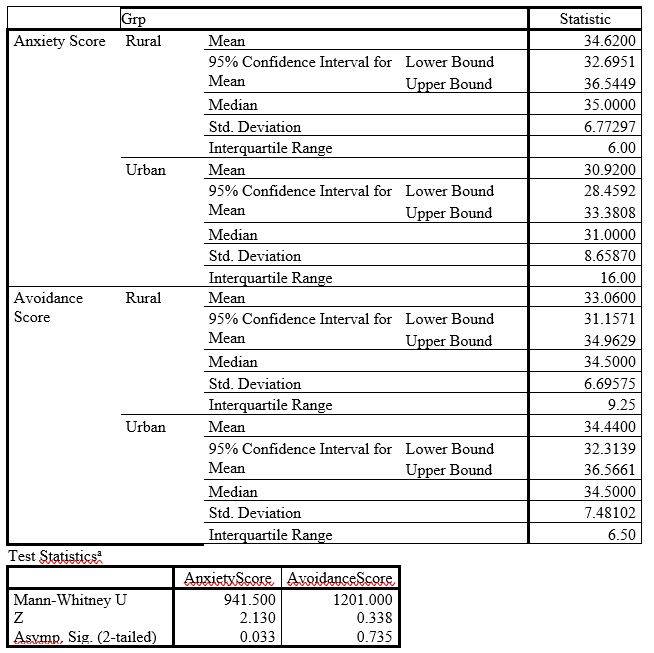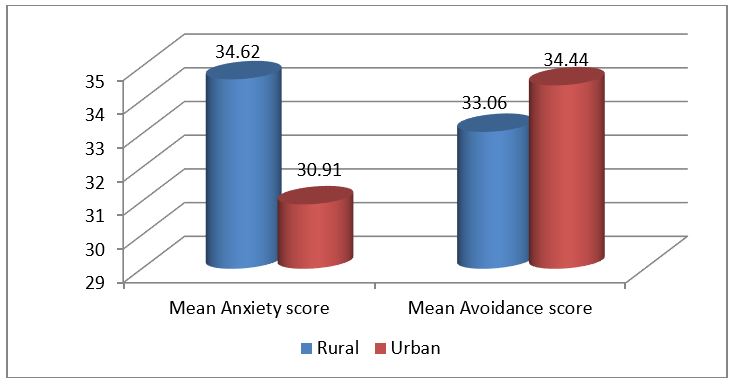International Journal of Epidemiology And Public Health Research
OPEN ACCESS | Volume 5 - Issue 1 - 2025
ISSN No: 2836-2810 | Journal DOI: 10.61148/2836-2810/IJEPHR
Shweta B Nanjannavar
Professor Department of Community Medicine,A.M . Shaikh Homeopathic Medical College, Bangalore.
*Corresponding author: Shweta B Nanjannavar, Professor Department of Community Medicine,A.M . Shaikh Homeopathic Medical College, Bangalore.
Received: July 05, 2025| Accepted: July 25, 2025| Published: July 28, 2025
Citation: Shweta B Nanjannavar., (2025) “A Comparative Study on Prevalence of Social Phobia in School-Going Adolescents in Urban and Rural Area of Shivamogga” (Karnataka) – A Comparative Cross Sectional Study”. International Journal of Epidemiology and Public Health Research, 7(1); DOI: 10.61148/2836-2810/IJEPHR/158.
Copyright: © 2025. Shweta B Nanjannavar. This is an open access article distributed under the Creative Commons Attribution License, which permits unrestricted use, distribution, and reproduction in any medium, provided the original work is properly cited., provided the original work is properly cited.
Social phobia in children always gets neglected by the health care providers, teachers and parents. Social phobia, which is also known as social anxiety disorders, is a serious mental health problem in India with an incidence of 2.79% and prevalence of 1.47%, Hence the current study is taken up estimate the prevalence of the same in Karnataka.
Aim- To compare the prevalence of social phobia among school going adolescents in an urban and rural area of Shimogga.
Methodology - Its an Observational Comparative study were the subject for the study were taken from schools of an urban and rural area of Shimogga. Informed consent was taken from the guardians after explaining the purpose of study. Liebowitz Social Anxiety Scale (LSAS) questionarrie was used for Data collection. Male and female school going adolescents aged from 14-16 years were considered for the study. Those Students suffering from psychosomatic illness and under any other medications of psychiatric illness were excluded.
Result- Mann-Whitney U test has been applied to see the difference between rural and urban total scores. Mean anxiety score in rural (34.6) subjects is higher than urban (30.91) subjects whereas the mean avoidance score in urban subjects (34.44) is higher compared with rural subjects. There is a significant difference between means of total anxiety scores of rural and urban areas. (P = 0.033). Anxiety is more in rural area as compared to urban area.There is no significant difference between means of total avoidance scores of rural and urban areas. (P = 0.735). Avoidance is almost same in both rural and urban areas.
Conclusion: The prevalence of social phobia in school – going adolescents in Shimoga District of Karnataka is 85% out of which Urban area prevalence is 45% with 40% in rural area adolescent group. The current study was comparative between Urban & Rural population of Shimoga district, Karnataka. This study was restricted to only Shimoga District , Karnataka. This study needs to be taken in larger group of population for better conclusive remarks.
The term social phobia (phobic-des-situation socials) was first coined by Janet in 1903. Social phobia is defined by DSM-IV-TR ( Diagnostic and statistical manual of mental disorders) as an anxiety disorder characterised by a strong and persistent fear of social are performance situation in which the patient might feel embarrassment or humiliation.
As a group, anxiety disorders are the most common, but least diagnosed, transient fear and anxiety occur in all typically developing children. Fear is an adaptive response. In phobic states there is a persistent and irrational fear of specific objects, activities or situations. This leads to avoidance of the objects or situations. The fear may be due to the defence mechanism of displacement, that is it is transferred from its true, but unconscious, source of the phobic object.
Social phobia, which is also known as social anxiety disorders, is a serious mental health problem in India with an incidence of 2.79% and prevalence of 1.47%.
The onset of social phobia almost always occurs in childhood or the mid-teens; onset after the age 25 is unusual. The diagnosis is found a lifetime prevalence of 11.9% in males and 15.5% in females. The age of onset was 14.8 years in males and 16.3 for females. The disorder is often a lifelong problem, although its severity may diminish in adult life. Adults and Adolescents with social phobia, as well as many children with disorders, have sufficient insight to recognise that their fears are excessive and unwanted. This factor often adds to their distress and Social phobia is of major concern to society as a whole for two reasons. One reason is the disorder’s very high rate of co-morbidity with such other mental health problems as major depression and substance abuse. The second is the laws to the larger society of the gifts and talents that these patients possess. Thereby, early diagnosis of this condition is imperative.
With reference to recent study done in 2017 with prevalence of social phobia in rural population at Ramnagara district Karnataka. Hence the current study is taken up to have a comparison between urban and rural students with social phobia.
Review of literature:
2.1 History and concept of social phobia:
Social phobia entered the dictionary of psychiatry half century ago, as “an isolated disorder discrete from specific phobias and agoraphobia as reported by Marks and Gelder, 1966 “. After that, the concept of social phobia changed from being a comparatively neglected condition to be recognised as a highly prevalent disorder across the world and is now termed as “social anxiety disorder or SAD “
“According to the Diagnostic and Statistical Manual of Mental Disorders DSM-V; American Psychiatric Association, 2013, social anxiety disorder is defined as marked intense fear of social or performance –based situations where scrutiny or evaluation by others may occur “.
Epidemiology of social phobia:
Social phobia, which is also known as social anxiety disorders, is a serious mental health problem in India with an incidence of 2.79% and prevalence of 1.47%. Phobia are included under anxiety disorders as per the current DSM-5 criteria, with weighted prevalence values of 4.2%and 5.8% respectively. Urban communities had higher prevalence rates (35.7%vs 13.9%;P<0.01)than rural communities .as per the above introduction we took reference to recent study done in 2017 with prevalence of social phobia in rural population at Ramnagara district Karnataka based on that rural epidemiology in Karnataka consider as ,the prevalence of SAD was 39.7%.The mild ,moderate and severe SAD accounted for 24.1%,13.9% and 1.6% , respectively. it was more in the female adolescents (47.7%) and age group of 11-13 years (43.4%). The mean score was 18.23%and it was higher for female adolescent.
Risk and Prognostic Factor:
Clinical manifestation of social anxiety disorder (SAD) or Social Phobia:
Anxiety is the most common emotional disorder. The disorder manifests itself physical and psychological symptoms. The child is shy, timid, over-dependent on parents and mixes poorly with other children. The fears are often exaggerations or extreme examples of normal fears, often involving harm or loss to the family, death or some other disaster. The child has difficulty getting off to sleep at night, with the sleep pattern interrupted by frequent wakening and nightmares. Common physical or somatic symptoms. Panic attacks may also occur. The severity of the anxiety state may fluctuate quite markedly, with exacerbations at times of stress, for instance starting or changing school.
3. Aims And Objectives Of The Study
Hypothesis: There will be significant association between knowledge and attitude regarding social phobia among adolescent with selected demographic variables.
Assumptions: The study may help adolescents to get knowledge regarding social phobia.
Methodology: -
Source of Data:
The subject for the study will be taken from schools of an urban and rural area of Shimogga.
Type of study: - Observational Comparative study.
Sample size: - Minimum 100 students, 50 from urban and 50 from rural are considered for the study.
Sample design: - Non–Experimental Descriptive study Design.
Tools for study: -Liebowitz Social Anxiety Scale (LSAS).
Selection criteria for participating subjects: -
Inclusion criteria:
1. Children in the age group of 14-16 years attending school.
2. Both male and female students.
3. Children available during the period of study.
Exclusion criteria:
1. Children below the age of 14 and above the age of 16 years.
2. Parents who refuse to give consent for participation.
3. Children suffering from psychosomatic illness.
4. Children under any other medications
Statistical analysis

Statistical analysis: Mann-Whitney U test has been applied to see the difference between rural and urban total scores as the data was not normal.
Conclusion: There is a significant difference between the means of total anxiety scores of rural and urban areas. (P = 0.033). Anxiety is more in rural areas as compared to urban areas.
There is no significant difference between means of total avoidance scores of rural and urban areas. (P = 0.735). Avoidance is almost same in both rural and urban areas.

Table 1.0 Anxiety / Avoidance Score chart
|
|
Rural |
Urban |
|
Mean anxiety score |
34.62 |
30.91 |
|
Mean avoidance score |
33.06 |
34.44 |
Data collection: Prior formal permission was obtained from school authority.Informed consent was obtained from the parents after explaining the purpose of study.
Data will collect by using structure interview schedule administrator to the subject to assess the demographic status and structure interview schedule to assess knowledge of social phobia among adolescents.
Duration of study: - 6 months.
Implication: - Social phobia in children always gets neglected by the health care providers, teachers and parents. This problem is successfully treated by identifying and removing the precipitating factors of phobia through the LSAS scale. Through this prevalence study we can know whether the urban or rural group of school going adolescents are more affected by social phobia. Parents and teachers are motivated to review and revise their family attitude through remedial measures.
Ethical clearance has been obtained from the institution.
Discussion: According to Graph 1, it is suggestive of social phobia scoring specifying about severe incidence of 8% in urban population to that of rural 2%. According Graph 2, the suggestion of mean social phobia scores higher in urban (67.86) population to that of rural (65.02). According to Graph 3 is suggestion of prevalence of social phobia in school-going adolescents’ group of Shimoga district of Karnataka is 85% out of which urban area is 45% with 40% in rural area.
Conclusion :Social phobia 2 reasons high rate of co-morbidity, with other mental health problems early diagnosis of this condition is imperative. With reference to recent study done in 2017 with prevalence of social phobia in rural population at Ramnagar (dist) Karnataka. The current Comparative study is taken up to estimate prevalence of social phobia in Shimoga, Karnataka. The components of social phobia score which MAS & MAvS is higher in urban population in comparison to that of rural population. Hence the total social phobia score remains higher in urban adolescents’ group.
The prevalence of social phobia in school – going adolescents in Shimoga District of Karnataka is 85% out of which Urban area prevalence is 45% with 40% in rural area adolescent group. The current study was comparative between Urban & Rural population of Shimoga district, Karnataka. This study was restricted to only Shimoga District, Karnataka. This study needs to be taken in larger group of population for better conclusive remarks.